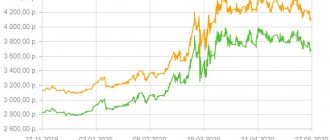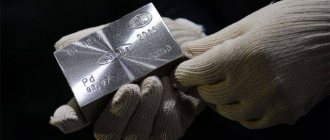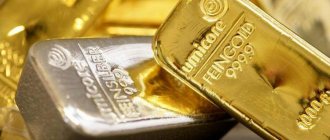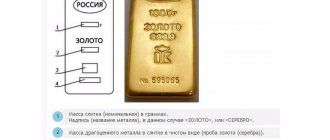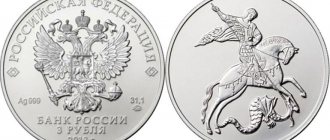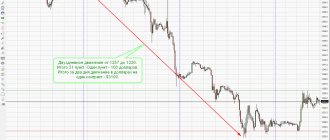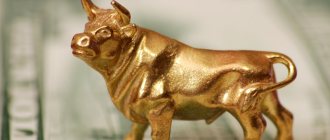Post updated: Jul 11, 2020
Gold has long been a kind of standard of material value. Now its meaning has changed somewhat, but not so much as to ignore its value on world markets. Of course, the gold price chart over the past 10 years shows interesting fluctuations in the value of the yellow metal. The initial strong growth has given way to a gradual decline recently.
The cost of a gram of gold 2000-2020 according to Yandex.
Of course, the graph of gold growth even over 10 years eloquently shows significant price fluctuations, which depend on many factors. It is worthwhile to dwell in more detail on the reasons on which the indicators of the value of the yellow metal depend.
Current gold rate
The main advantage of investing in gold metal is the guaranteed opportunity to preserve savings even during high inflation levels and other negative crisis processes. The current bank price of gold is published daily on the official Internet resource of the Central Bank of Russia. It is necessary to understand that the purchase rate and the sale rate of gold are always noticeably different, and always in favor of the bank.
At the moment, the average price of the precious metal is variable and fluctuates around 4.736 rubles per gram. The dynamics of the price of gold is strongly influenced by the conditions of the international gold market and world currency rates. Yellow metal is sensitive to any changes in global politics and economics. He always reacts sensitively to significant events in the world.
Increase in prices for rolled metal products and dynamics of prices for fittings in Russia in 2021 and 2021
Over the past year, Russia has seen an increase in prices for rolled metal products. As a result, household appliances, cars and many other groups of goods become more expensive. Let’s try to understand the reasons for the rise in prices for rolled metal, talk about the dynamics and when the increase in the cost of metal and fittings will stop. The largest price monitoring site provides its statistics:
Rising prices for rolled metal products
Amid the ongoing coronavirus pandemic, stock prices for rebar have reached record levels. Rising prices for rolled metal products in 2021 have crippled metal consumers, especially in the construction of reinforced concrete and warehouse structures.
President of the National Association of Builders (NOSTROY) Anton Glushkov voiced the following reasons for rising prices:
- Financial factors. An increase in prices for rolled metal products in 2021 is observed across the entire range of raw materials. There are many reasons: the unstable situation in the financial and credit sphere of the Central Bank, the delay in delivery of goods due to restrictive measures taken, etc.
- The current situation on the metals market. The rise in prices for rolled metal products is the latest news - the cost has reached a historical maximum. This is due to increased demand, the lag of domestic producers and increased imports. Financial support for the population and assistance to businesses ensured the solvency of metal consumers.
- Sanctions. The assets of leading metal producers were included in the sanctions list. The price on the stock exchange jumped sharply and returned to its initial levels only after the restrictions were lifted.
- Increase in the tax rate for mining. From January 1, 201, the mineral extraction tax rate was multiplied by the rental coefficient. It is likely that such measures will hit the pockets of metal consumers, causing an increase in prices for all metal products.
What is the reason for the price increase?
Analysts attribute the rise in prices to the recovery of the global economy, which faced serious challenges during the global lockdown. Rising metal prices will have an impact on all areas of the economy, from the production of household appliances to shipbuilding.
Experts answer what is causing the rise in prices for rolled metal with preferential mortgages. The demand for the construction of residential complexes has increased, and a construction boom is observed.
When will the rise in prices for rolled metal products stop?
Experts call the date when the rise in prices for rolled metal products will end. Easing can be expected by the end of 2021. This is a temporary phenomenon that cannot last forever. A set of measures have already been taken to curb prices on the rolled metal market. The Ministry of Industry and Trade proposed adding ferrous metallurgy products to the list of critically important products. As temporary emergency measures, it is proposed to introduce an export duty on steel products, an increase in the profit tax rate and the mineral extraction tax for metallurgical and mining enterprises.
The fall in prices will not be sharp and fast. The market is oversaturated with products. With the arrival of the season, the demand for products increases, but prices remain unchanged. A reduction should be expected when the situation on the world market stabilizes.
Dynamics of price growth for rolled metal products
The dynamics of growth in prices for rolled metal in 2021 are similar to the increase in the cost of rolled metal in previous periods, only the leaders have changed. Sheet metal is in greatest demand.
Dynamics of prices for corrugated sheets (profiled sheets, metal profiles)
Dynamics of prices for profile pipes
Armature
On average, the dynamics of prices for fittings has increased in 2021. There is an increase in prices for fittings and other rolled metal products by 1.5-2 times. In this regard, the price of products containing metal has also increased, which affects absolutely all areas of industry, construction and economic activity.
Dynamics of prices for fittings
The rise in price of fittings in Russia is associated with increased demand for metal. In the warehouse market, speculators artificially increased prices. Demand has exceeded supply, which is why the price of rolled metal has risen so much. What came as a shock to the end consumer was how much the price of the metal had risen.
Dynamics of prices for fittings by year
Reinforcement is a popular rolled metal product that is produced in large volumes. The dynamics of prices for reinforcement depends on the situation in steel production. It is necessary to evaluate the prices of iron ore, coal, transportation costs, electricity, etc. The price growth schedule for rolled metal products will constantly change, the final cost will increase.
The graph clearly shows the increase in prices for A500C 8 mm reinforcement over the past 10 years (data from the mcena.ru portal):
The graph shows how serious the rise in prices for rolled metal products has become. Even taking into account the general level of inflation, the increase in price was significantly more than 100%.
Popular brands of fittings
Among the reinforcing bars, the brands A500c, A3 and others are in greatest demand. This grade has higher ductility and better weldability.
Price of fittings on the stock exchange
The price forecast is calculated daily, based on the most popular types of metals. The price dynamics for A500C fittings is as follows:
The graph clearly shows how significant the increase in price was. The same applies to other rolled metal products:
The data is presented by the price monitoring portal mcena.ru.
The reason for the rise in prices for fittings
Rebar price statistics suggest that costs have increased by at least 70% since the beginning of 2021. These data are provided by the online publication RBC, citing the FAS. When constructing a modern residential complex, it is impossible to do without reinforcement. The price jump was such that the construction estimate drawn up at the end of 2020 was no longer relevant at the beginning of 2021.
The price jump was due to a shortage of metal; by the spring of 2021, warehouses were empty. At this moment, many rushed to buy fittings; manufacturers were not ready for such demand and took advantage of the opportunity to raise the cost of their products.
Domestic construction companies, manufacturers of metal structures and metal products suffer from this pricing policy. The market needs a regulator who can protect it from sudden changes.
The authorities' reaction to the rise in prices for rolled metal products
Despite the fact that all metal products and structures intended for production and construction increased in price by approximately 25-80%, the most significant increase in prices was for fittings. In just one month they increased by 29% and by December 18 last year reached 41.9 thousand rubles. per ton. And by February 1, 2021, the price was already 46 thousand rubles. per ton.
The authorities could not help but pay attention to this situation; as a result, antimonopoly officers not so long ago, around the end of spring of this year, discovered signs of collusion among sellers of metal structures.
Back in December 2021, the Federal Antimonopoly Service of the Russian Federation began its investigation into rising prices on the metal products market, and already in February it became clear that there were signs of anti-competitive collusion among a number of sellers, including the largest in the industry. According to the department, we are talking about traders “Stalepromyshlennaya” and “Metallokomplekt-M”. They received more than 30 complaints. But Deputy Head of the FAS Andrei Tsarikovsky, in an address to the Ministry of Industry and Trade, said that the service conducted an investigation, but did not reveal any signs of violation of antimonopoly legislation.
The key danger of this situation is that not only the rolled metal products themselves become more expensive, but also the majority of goods that are in one way or another connected with the use of metal products. Real estate prices have risen especially significantly. The main danger, according to experts, is seen in an even greater jump in prices per square meter. This will seriously affect developers, since prices in government construction contracts cannot be adjusted.
The Ministry of Construction reports that at the end of last year, regular monitoring of prices for building materials and rolled metal products was organized. According to the authorities, such a step was supposed to help build a dialogue between metallurgists and consumers of their products, and accordingly, contain prices for their goods.
Difficulties of import substitution and ruble devaluation
One of the factors in the rise in prices for fittings and rolled metal is fluctuations in exchange rates, which cannot be discounted, since many Russian factories purchase imported components. Especially often, domestic metallurgists purchase foreign electronics and specific complex equipment, without which it is impossible to establish the production of steel, fittings and rolled metal products that would comply with generally accepted GOST standards.
In addition to rising prices for metal products on world markets, a significant increase in prices in ruble terms is associated with the devaluation of the ruble against leading world currencies. For example, in 2020, the fall of the ruble against the US dollar and the Euro was about 25-30%, which, along with rising prices in currency terms, created an explosive effect for the Russian market.
What are the experts' forecasts?
Analysts agree that the eternal rise in price of this or that product is, in principle, impossible, but the current situation does not suit the Russian consumer much. Many manufacturers have reoriented themselves to Western markets, where they can sell their goods at a higher price than in Russia, because in the country antimonopoly officials are actively fighting against inflated prices. This creates an artificial shortage, which, in turn, negatively affects the domestic rolled metal market. Sellers, seeing increased demand, raise prices even higher.
There is every reason to believe that the situation will return to normal within a couple of months. At least, this is what representatives of the largest Russian departments say. Sellers of metal products are already optimizing warehouse stocks, because this is the only way to achieve guaranteed sales of products. Now a critically large volume of rolled metal products has settled as dead weight in warehouses due to artificial shortages and inflated prices of goods. And a number of large buyers are already complaining about a lack of funds, which may entail the threat of disruption of current contracts.
Experts do not see any significant prerequisites for prices to continue to rise. On the contrary, global trends promise a reduction in the cost of steel products. In the Russian Federation, perhaps, the highest prices for metal will be in June, and already in July it is planned to reduce the cost of goods in the industry by 10-15 percent. And first of all, this concerns long products.
If Russian manufacturers turn out to be interested in artificially maintaining inflated prices for rolled metal products, the authorities will have to intervene. Although they now say that the influence on the cost of steel products is exclusively market-based, even without their targeted actions this would hardly have become possible. However, although the fall will occur later, it will be even more widespread.
Tags: Russian_market fittings price_rise
Share
What will the price of physical gold be?
Over the past decade, the price of gold has changed dramatically. More than 10 years ago, one troy ounce of the yellow metal cost about $270-$290 dollars. In 2011, the precious metal rose in price to $1,600 per troy ounce. After 2021, its value continued to rise. A slight decline occurred against the backdrop of the global economic crisis in 2008. But such negative factors as the default in Greece, Brexit, military conflicts in Ukraine and the Middle East, civil unrest in Belarus and the United States, the severe economic consequences of the coronavirus pandemic - all this only contributes to the upward dynamics of the gold rate and prepares for another price rise.
Factors that influence price growth or decline
The financial crisis of 2021 is an impetus for an increase in gold prices, which can be seen in this chart.
Thus, the cost of yellow metal is influenced by many reasons, among which it is worth highlighting the most significant and significant:
- First of all, fluctuations in the gold rate directly depend on changes in the exchange rate of the American currency;
- Developing countries in southeast and east Asia, India and China have been driving up prices in recent years. This is due to the growth of middle class consumers, who have recently increasingly begun to buy jewelry;
- Financial crises, political instability, civil unrest and environmental disasters - all these factors have a significant impact on the price of the yellow metal.
There are many more reasons that may affect the gold price chart over the past 10 years.
What determines the gold selling price?
Pre-holiday days are considered unfavorable for gold investments, when the demand for gift jewelry increases and, accordingly, the gold sales rate increases. In Europe and the USA it is Christmas and Thanksgiving. In Asia, it’s wedding season and New Year’s Eve (according to the lunar calendar). In Russia - New Year, March 8th and Valentine's Day, which came to us from the West.
These are all seasonal changes in gold prices that should be taken into account as they occur every year. They do not depend on political and economic events. However, if you do not take them into account, then it will simply not be profitable to invest in the precious metal. And lastly, it is better to purchase and sell gold products through banks, trusted dealer companies and official exchanges. Hand trading can be unsafe.
Dynamics of gold prices over the past 10 years in Russia in rubles
An excellent visual example is the graph of exchange fluctuations in gold prices over the past ten years:
To create the most complete picture possible, take a look at the data on how the average price of gold changed, presented in the table:
| Year | End of year price | % change |
| 2018 | 2670.58 | +11.22 |
| 2017 | 2400.97 | +6.21 |
| 2016 | 2260.43 | -9.65 |
| 2015 | 2502.1 | +16.58 |
| 2014 | 2146.08 | +69.74 |
| 2013 | 1264.3 | -21.88 |
| 2012 | 1618.56 | -0.7 |
| 2011 | 1629.81 | +17.84 |
| 2010 | 1383.06 | +30.19 |
| 2009 | 1062.32 | +29.26 |
| 2008 | 821.8 |
Price chart in dollars per ounce:
How ETFs Changed the Gold Market in 10 Years
Investors are celebrating the 10th anniversary of the world's first gold exchange-traded fund. ETFs have had a major impact on the gold market, making the metal more accessible to retail investors. At the same time, they also caused a number of problems.
“It is now clear to everyone that the launch of ETFs had a strong impact on the gold market. Today, funds are a key part of it,” said Graeme Takuel, head of ETF Securities, in a press release.
Fig.1
On March 28, 2003, the first gold ETF, developed by ETF Securities experts, was launched on the market, had $191 thousand under management. It is now traded on the Australian Stock Exchange, the volume of assets under management is approximately $602 million.
Since the launch of the exchange-traded fund, interest in gold has grown astronomically, against the backdrop of rising metal prices from $332 to $1,600 per ounce (at a maximum of $1,920/troy ounce).
There are currently about 143 gold ETFs in the world, with total assets of about $132 billion.
The first gold ETF in the United States, the SPDR Gold Trust (GLD), launched on November 18, 2004. At the moment, this is the largest fund on the market, with a total asset value (investing not only in gold) of $63 billion.
With fund asset values at this level, "gold has transformed from a speculative commodity to a fundamental basis for portfolio construction," Tom Lydon, editor and publisher of ETFtrends.com, said recently. He believes that "gold ETFs have emerged as real challengers to the world's central banks, something that would have been unimaginable just 10 years ago."
If we add up all the physical reserves of gold in the accounts of “gold” ETFs, then this volume will take 4th position in the world ranking of the largest holders of gold, right after the USA, Germany and the IMF, while ahead of Italy, France and other developed countries with a high share of gold in their reserves.
Left a trace
Among the main reasons for the popularity of gold ETFs is their accessibility to the average investor and added liquidity. However, their appearance also added volatility.
Availability
Before the advent of the first gold ETF, investing in gold was quite problematic: you could buy bars or coins, but due to high spreads and storage costs, these instruments were used only by industry specialists, which did not add transparency and efficiency to gold investments.
The introduction of ETFs made it possible for people to trade gold in exactly the same way that they had been trading stocks for many decades.
Some gold ETFs buy physical gold (stored in the vaults of large banks), the other part invests in futures contracts (deliverable). By purchasing a share of a physical gold ETF, an investor actually becomes the owner of the metal.
“Over the long term, ETFs make it easier for gold to get into the hands of the investing community while virtually eliminating the risks of poor management,” says Brian Lundeen, editor of the Gold Newsletter.
However, there is also some negativity associated with gold ETFs
“ETFs are not a substitute for gold bullion,” says Luke Rahbary, managing partner at private equity firm Stutland Volatility Group. “Increased liquidity has created a challenge: how to control large volumes of gold without affecting the market itself?” In other words, further growth in the number of gold ETFs and the volume of funds under their management may disrupt the market pricing mechanism, which will significantly complicate the analysis for the average investor.
In addition, gold mining stocks have traditionally been vehicles through which investors have participated in changes in metal prices. However, it so happened that with the introduction of gold ETFs, the growth of the gold market and the price of the metal, investors began to transfer funds specifically to the funds (which, in essence, means owning the metal, without projections to the manufacturer), while withdrawing capital from the shares of gold mining companies.
Prospects for ETFs
This year, gold ETFs are not performing well. For example, SPDR Gold Trust has lost almost 5% (withdrawals) since the beginning of the year: in nominal terms, capital outflow from the fund amounted to about $6.6 billion (from December 31, 2012 to April 3, 2013) .
The George Soros Foundation reduced its stake in GLD by 55%. Another major holder of GLD shares, the Paulson & Co fund, is still maintaining its stake unchanged. How long?
Fig.2
The outflow of funds from gold ETFs is due to the current market situation: speculators are increasing short positions, which reduces the price of the metal and forces investors to withdraw funds from ETFs. By the way, the price of gold fell by 3.5% in the first quarter of this year alone.
However, experts are inclined to believe that the key drivers of rising gold prices - for example, the growth of US government debt - will not go away, which will ultimately overcome the resistance of skeptical speculators.
Additionally, while ETFs are some of the leading players in the gold market, a large volume of investment is still in bars and coins. And this is where analysts see growth potential for the ETFs market: more and more institutional investors, such as pension funds, will switch to ETFs. In Japan alone, more than 200 pension funds have begun including gold in their portfolios over the past 18 months, according to the World Gold Council.
BKS Express

